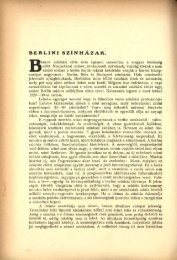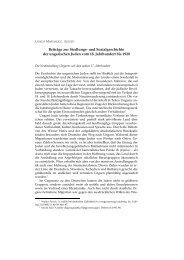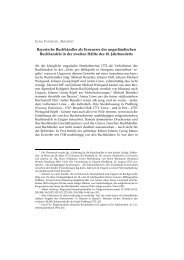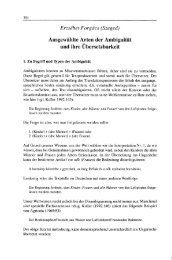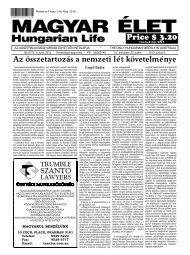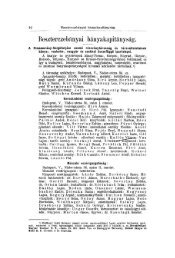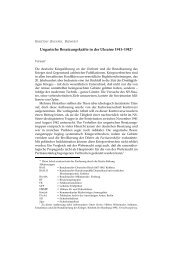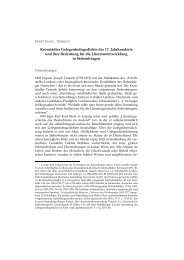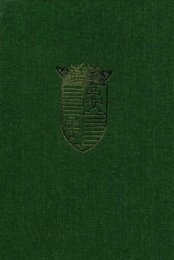Journal of Eurasian Studies - EPA
Journal of Eurasian Studies - EPA
Journal of Eurasian Studies - EPA
You also want an ePaper? Increase the reach of your titles
YUMPU automatically turns print PDFs into web optimized ePapers that Google loves.
July‐September 2010 JOURNAL OF EURASIAN STUDIES Volume II., Issue 3.<br />
_____________________________________________________________________________________<br />
“multilingualism” was conserved by the strict organization <strong>of</strong> society. Firstly, most <strong>of</strong> the inhabitants <strong>of</strong><br />
the Hungarian kingdom, i.e. 81 percent 16.923.000 lived in the country‐side in small agricultural<br />
settlements. Only the Hungarians and the Germans remained with 71 percent and 81 percent under or at<br />
this average respectively. Almost all the other nationalities lived in the country‐side, including Slovaks,<br />
Romanians, Croats and Serbs with 92, 95, 91, 90 percent respectively. Almost all the Ruthenians, i.e. 99<br />
percent lived in the country‐side. 26 Further, the nationalities were <strong>of</strong>ten organized in terms <strong>of</strong> church<br />
denominations. The Hungarian state recognized the Roman Catholic church, the Greek Catholic church,<br />
the Greek Orthodox church, the Calvinist church, the Lutheran church, the Unitarian church and the<br />
Jewish faith. These denominations enjoyed ecclesiastical autonomy. 27 Although the relation between<br />
ethnicity and church denominations was not a strict one‐to‐one matching in the Hungarian kingdom<br />
some churches were represented more dominantly than others among the different nationalities. Almost<br />
all the Croats, i.e. 99 percent were Roman Catholic. An equally high number <strong>of</strong> Serbs belonged to the<br />
Greek Orthodox Church. Almost all the Ruthenians, i.e. 98 percent were Greek Catholic. Most <strong>of</strong> the<br />
Hungarians were either Roman Catholic or Calvinist, i.e. 59 and 26 percent respectively. Most Romanians<br />
were either Greek Orthodox, i.e. 61 percent or Greek Catholic, i.e. 38 percent. 28 These church<br />
denominations were active in fostering the identity and language <strong>of</strong> the ethnic groups they were attached<br />
to. One <strong>of</strong> their effective vehicles to do this was by being an active player in the educational system.<br />
Finally, one <strong>of</strong> the main reasons why separate “multilingualism” existed in the Hungarian kingdom was<br />
due to the liberal Law on the Equality <strong>of</strong> the Nationalities in the Hungarian kingdom, i.e. Act XLIV. 1868.<br />
The law assigned the nationalities the right to establish their own schools and choose their own language<br />
<strong>of</strong> instruction in these schools.<br />
Fifthly, the legal situation <strong>of</strong> the nationalities was regulated in the Law on the Equality <strong>of</strong> Nationalities<br />
Act XLV. 1868. The Law counted 29 paragraphs stipulating individual and collective nationality rights<br />
referring foremost – in accordance with Smith’s generalization ‐ to the use <strong>of</strong> the languages <strong>of</strong> the<br />
nationalities. This law next to specifying the Hungarian language as the language <strong>of</strong> the state to be used in<br />
all branches <strong>of</strong> government and administration (compare § 1) recognized individual and collective rights<br />
for the nationalities, i.e. the Slovaks, Romanians, Serbs and so on to use all registers <strong>of</strong> their own mother<br />
tongue in <strong>of</strong>fices, schools, at courts and in county and communal assemblies. During the whole period <strong>of</strong><br />
dualism the Law on the Equality <strong>of</strong> Nationalities and their provisions were almost unchanged and<br />
remained into force. It was an effective tool for protecting the identity <strong>of</strong> nationalities, also against<br />
homogenization policies <strong>of</strong> Hungarian nationalism. Consider section 3 below for more discussion.<br />
The individual rights included the following rights among others. In county and communal<br />
assemblies, everyone had the right to speak its own mother tongue (compare § 3, §24) and to use the non‐<br />
state languages <strong>of</strong> the nationalities for the minutes <strong>of</strong> the county and communal assemblies, if more than<br />
twenty percent <strong>of</strong> the deputies asked for it (compare §2, § 20). The assemblies had the right to<br />
communicate internally (compare § 5) and with higher instances <strong>of</strong> the state and each other in the<br />
language(s) <strong>of</strong> the nationalities (compare §4) in agreement with § 2 and § 20. Further every citizen had the<br />
right to use its own mother tongue before court (compare § 7), to use his own mother tongue in church<br />
26 Compare Lökkös (2000, 63).<br />
27 See the study <strong>of</strong> Hévizi (1996).<br />
28 See Lökkös (2000, 65).<br />
_____________________________________________________________________________________<br />
© Copyright Mikes International 2001‐2010 38



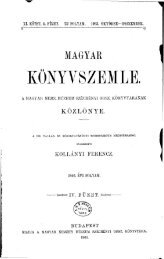
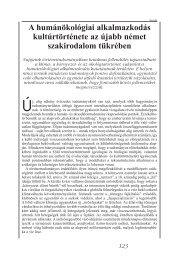
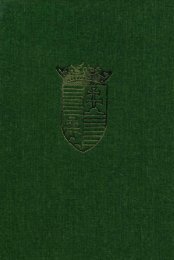
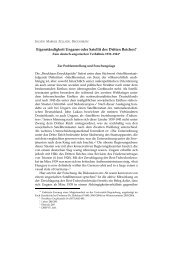
![Letöltés egy fájlban [36.8 MB - PDF] - EPA](https://img.yumpu.com/23369116/1/172x260/letoltes-egy-fajlban-368-mb-pdf-epa.jpg?quality=85)
